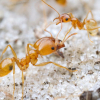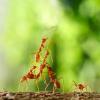I think most of us know that some larvae can produce substances that can feed workers, etc.
This research shows that PUPAE produce a substance that is useful to the colony. Even pupae in cocoons.
https://www.nature.c...586-022-05480-9
"[A]nt pupae extrude a secretion derived from the moulting fluid that is rich in nutrients, hormones and neuroactive substances. This secretion elicits parental care behaviour and is rapidly removed and consumed by the adults. This behaviour is crucial for pupal survival; if the secretion is not removed, pupae develop fungal infections and die. Analogous to mammalian milk, the secretion is also an important source of early larval nutrition, and young larvae exhibit stunted growth and decreased survival without access to the fluid. We show that this derived social function of the moulting fluid generalizes across the ants. This secretion thus forms the basis of a central and hitherto overlooked interaction network in ant societies[....]"
"To test whether this function is specific to O. biroi, we socially isolated pupae from four other species to cover the five major ant subfamilies: S. invicta (subfamily Myrmicinae), Nylanderia flavipes (Formicinae), Tapinoma sessile (Dolichoderinae) and Ponera pennsylvanica (Ponerinae). We found that melanized pupae of all four species secrete fluid droplets from the abdominal tip."



















